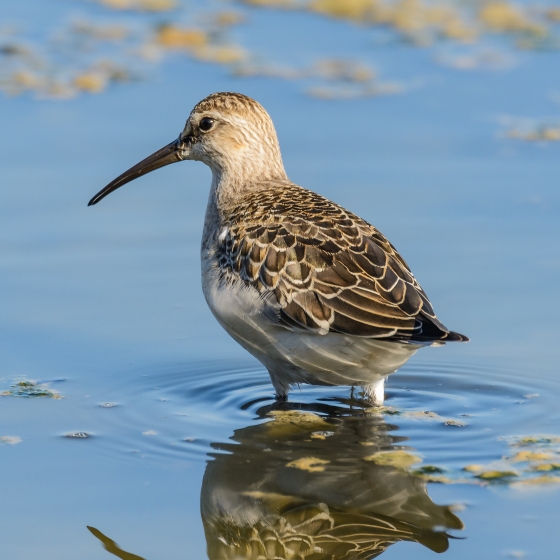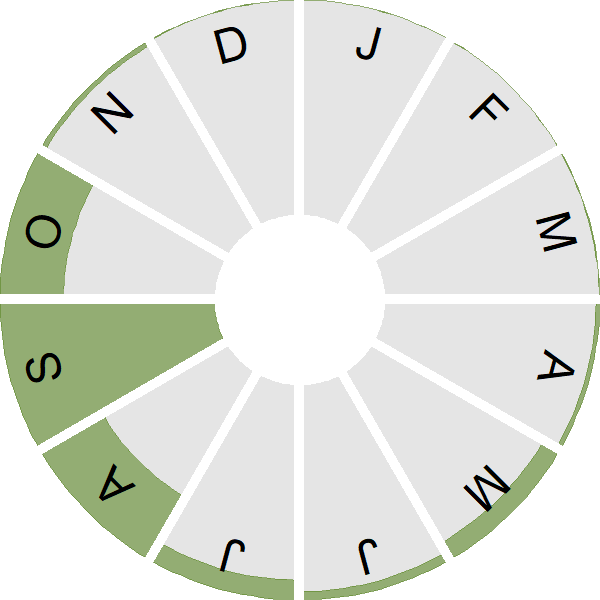Curlew Sandpiper

Introduction
A bit larger than a Dunlin, with a similarly down-curved bill, most records of this migratory wader are in the autumn.
This species breeds in northern Siberia and a small proportion of individuals migrate through Britain & Ireland to wintering grounds in western Africa. Autumn numbers are variable, and most of the records received through BirdTrack fall between August and early October. Birds present in July likely represent those whose breeding attempt has failed.
In winter it has a rather drab, grey appearance, but in summer dons an unmistakable brick-red dress that provides surprisingly good camouflage in its tundra breeding habitat.

Key Stats
Identification
ID Videos
This section features BTO training videos headlining this species, or featuring it as a potential confusion species.
Sanderling & Curlew Sandpiper
Songs and Calls
Call:
Status and Trends
Conservation Status
Population Size
Population Change
Curlew Sandpiper is a passage migrant, seen mostly during autumn passage (July to October) and scarcely in spring [Balmer et al. 2013]. It is not seen here in sufficient numbers to generate a UK population trend; however, at the flyway scale, the population trend shows a marked decline since the early 1980s [van Roomen 2022].
Distribution
Curlew Sandpipers are most frequently reported while on autumn passage in July–October and are scarce in spring. Over half the occupied 10-km squares on the winter distribution map are late-autumn migrants recorded in November. The few records of true wintering birds are all from coastal marshes or estuaries.
Occupied 10-km squares in UK
2007/08–10/11
or view it on Bird Atlas Mapstore.
2008–11
or view it on Bird Atlas Mapstore.
Distribution Change
Change in occupied 10-km squares in the UK
from 1981–84 to 2007–11
or view it on Bird Atlas Mapstore.
Seasonality
Curlew Sandpipers are regular passage migrant, mostly in autumn when numbers are swelled by returning juveniles.
Weekly pattern of occurrence
The graph shows when the species is present in the UK, with taller bars indicating a higher likelihood of encountering the species in appropriate regions and habitats.

Movement
Britain & Ireland movement
Foreign locations of birds ringed or recovered in Britain & Ireland
Dots show the foreign destinations of birds ringed in Britain & Ireland, and the origins of birds ringed overseas that were subsequently recaptured, resighted or found dead in Britain & Ireland. Dot colours indicate the time of year that the species was present at the location.
- Winter (Nov-Feb)
- Spring (Mar-Apr)
- Summer (May-Jul)
- Autumn (Aug-Oct)

European movements
EuroBirdPortal uses birdwatcher's records, such as those logged in BirdTrack to map the flows of birds as they arrive and depart Europe. See maps for this species here.
The Eurasian-African Migration Atlas shows movements of individual birds ringed or recovered in Europe. See maps for this species here.
Biology
Productivity and Nesting
Survival and Longevity
Survival is shown as the proportion of birds surviving from one year to the next and is derived from bird ringing data. It can also be used to estimate how long birds typically live.
View number ringed each year in the Online Ringing Report.
Lifespan
Biometrics
Wing length and body weights are from live birds (source).
Wing length
Body weight
Ring Size
Classification, names and codes
Classification and Codes
- Order: Charadriiformes
- Family: Scolopacidae
- Scientific name: Calidris ferruginea
- Authority: Pontoppidan, 1763
- BTO 2-letter code: CV
- BTO 5-letter code: CURSA
- Euring code number: 5090
Alternate species names
- Catalan: territ becllarg
- Czech: jespák krivozobý
- Danish: Krumnæbbet Ryle
- Dutch: Krombekstrandloper
- Estonian: kõvernokk-rüdi e. kõvernokk-risla
- Finnish: kuovisirri
- French: Bécasseau cocorli
- Gaelic: Luatharan-guilbneach
- German: Sichelstrandläufer
- Hungarian: sarlós partfutó
- Icelandic: Spóatíta
- Irish: Gobadán Crotaigh
- Italian: Piovanello comune
- Latvian: likšnibitis
- Lithuanian: riestasnapis begikas
- Norwegian: Tundrasnipe
- Polish: biegus krzywodzioby
- Portuguese: pilrito-de-bico-comprido
- Slovak: pobrežník krivozobý
- Slovenian: srpokljuni prodnik
- Spanish: Correlimos zarapitín
- Swedish: spovsnäppa
- Welsh: Pibydd Cambig
Research
Publications (1)
More Evidence
More evidence from Conservation Evidence.com
Partners
Citing BirdFacts
If you wish to cite particular content in this page (e.g. a specific value) it is best to use the original sources as linked in the page. For a more general citation of the whole page please use: BTO (20XX) BirdFacts Species: profiles of birds occurring in the United Kingdom. BTO, Thetford (www.bto.org/birdfacts, accessed on xx/xx/xxxx).

